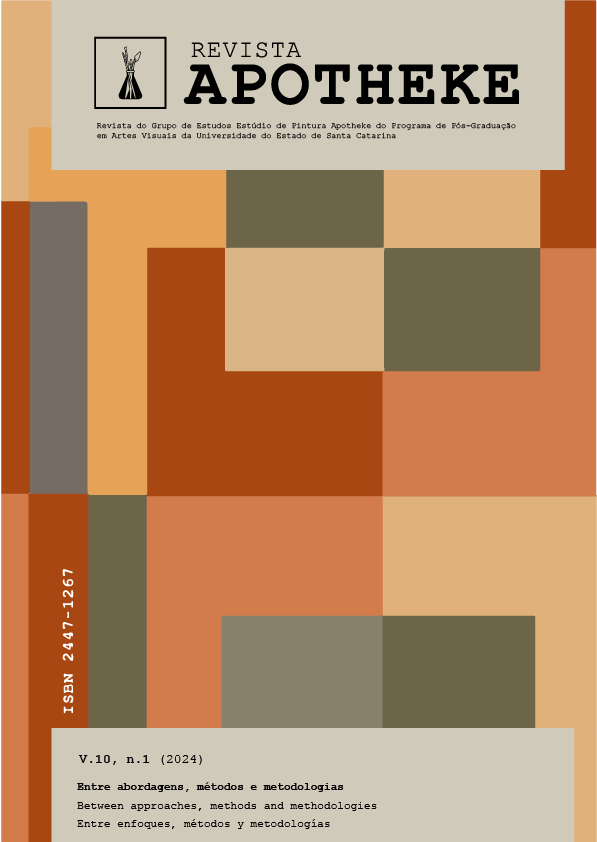Diálogo con los tratadistas antiguos: sobre geometría y procesos pictóricos contemporâneos
DOI:
https://doi.org/10.5965/244712671012024277Palabras clave:
pintura, práctica de taller, composición, geometría, sección aureaResumen
En el siglo XX hubo un movimiento estético ganador. Se ha impuesto más o menos por encima de todos los demás. Ese movimiento es el expresionismo. Su predominio abrumador como propuesta estética universal se ha afirmado en todas sus formas en gran parte del sistema del arte contemporáneo y, concomitantemente, en muchas de las prácticas pedagógicas de las escuelas de artes visuales. Dado que en nuestra práctica docente detectamos evidentes dificultades expresadas por los estudiantes de artes visuales en relación con la composición pictórica, proponemos una relectura, estudio y reinterpretación contemporánea de los procesos geométricos utilizados de diversas maneras por los maestros antiguos.
Descargas
Citas
ALBERTI, Leon Battista. De la pintura y otros escritos sobre arte. Madrid: Editorial Tecnos, 1999.
BOULEAU, Charles. Tramas: La geometria secreta de los pintores. Madrid: Akal, 1996.
BRANCO, Rosa Alice. A Condição secreta do visível: a percepção na natureza e nas artes. S. Paulo: Escrituras, 2009.
BURSILL-HALL, Piers. Why do we study Geometry? Answers through the ages. Cambridge: University of Cambridge, 2002.
CACHORRO-FERNÁNDEZ, Emílio. Geometry in architecture and art of the 20th century: The cube as reference shape, Goya, n.338, jan-mar, p.76-83, 2012.
CASIMIRO, Luis Alberto. Quatro pinturas do retábulo da Sé de Lamego: análise iconográfica e geométrica, Ciências e Técnicas do Património, I Série vol. 2, pp. 443-472, 2003.
COLMAN, Samuel. Harmonic proportion and form in nature, art and architecture. Nova Iorque: Dover Publications Inc., 2003.
COXETER, H.S.M. Projective Geometry. Berlim: Springer-Verlag, 1987.
FIELD, J.V. The invention of infinity, Oxford: Oxford University Press, 1997.
GHYKA, Matila C. Estética de las proporciones en la naturaleza y en las artes, 3ª Ed. Barcelona: Editorial Poseidon, 1983.
HARTSHORNE, R. Foundations of Projetive Geometry, Reading: Benjamin Cummings, 1967.
HAWKING, Stephen. Aos ombros dos gigantes. Lisboa: Texto Editores, 2010.
HUNTLEY, H. E. The divine proportion: A study in mathematical beauty. New York: Dover Publications, Inc., s.d.
JOHNSON, Paul. (2007) Criadores. Lisboa: Alêthea Editores, 2007.
KLINE, M. Foreword in: Russel, B.A.W. An essay on the foundations of geometry. New York: Dover Publications. 1956.
LICHTENSTEIN, Jacqueline (Org.) A Pintura, Textos essenciais, Vol3. S. Paulo: Editora 34, 2008.
LIVIO, Mario. The Golden Ratio: the story of phi the most astonishing number. New York: Broadway Books, 2003.
PACIOLI, L. La divina proporción. Madrid: Akal, 1991.
PANOFSKY, Erwin. A perspectiva como forma simbólica. Lisboa: Edições 70, 2006.
PEDOE, Dan. Geometry and the visual arts. Nova Iorque: Dover Publications Inc., 1976.
RAILING, Patricia; WALLIS, Caroline. Beyond the horizon: Coherent geometric systems in Rodchenko´s painting. Structurist, n.49/50, p.66-73, 2009/2010.
SIDNEY, Tillim. What Happened to Geometry. Arts Magazine, jun59, Vol.33 (9) p.38-44, 1959.
Descargas
Publicado
Cómo citar
Número
Sección
Licencia
Derechos de autor 2024 Leonardo Charréu

Esta obra está bajo una licencia internacional Creative Commons Atribución-NoComercial 4.0.
Política de Derechos de Autor y Licenciamiento
Los autores de los trabajos enviados a la Revista APOTHEKE autorizan su publicación en formato impreso y digital, exclusivamente con fines académicos, pudiendo ser reproducidos siempre que se cite correctamente la fuente. Los autores certifican la originalidad, autoría y carácter inédito de sus manuscritos.
Los artículos publicados por la revista están disponibles gratuitamente y destinados a fines académicos y no comerciales. Todos los derechos de autor son cedidos a la revista. Los artículos firmados representan exclusivamente la opinión de sus autores y no reflejan la posición oficial de la Revista Apotheke. Los autores se comprometen a citar la publicación original siempre que reproduzcan, divulguem o hagan referencia al artigo publicado en la Revista Apotheke, de la siguiente forma:
“Este artículo fue publicado originalmente por la Revista Apotheke en el volumen (colocar el volumen), número (colocar el número), en el año (colocar el año), y puede ser consultado en: http://www.revistas.udesc.br/index.php/APOTHEKE/index”
Es responsabilidad exclusiva de los autores obtener autorización por escrito para el uso de cualquier material protegido por derechos de autor incluido en sus artículos. La Revista Apotheke no se responsabiliza por eventuales infracciones cometidas por sus colaboradores.
Los autores conservan los derechos de autor y conceden a la revista el derecho de primera publicación, bajo la licencia Creative Commons de tipo Atribución-NoComercial (CC BY-NC):
-
Atribución (BY): Los licenciados pueden copiar, distribuir, mostrar, ejecutar y crear obras derivadas, siempre que se otorgue el crédito correspondiente al autor o titular de la licencia, en la forma indicada.
-
Uso No Comercial (NC): Los licenciados pueden usar el material solo con fines no comerciales.
Después de la publicación, los autores conservan sus derechos de autor y pueden volver a publicar el texto.



